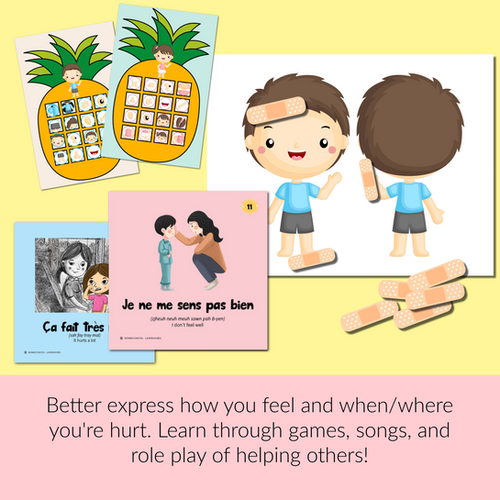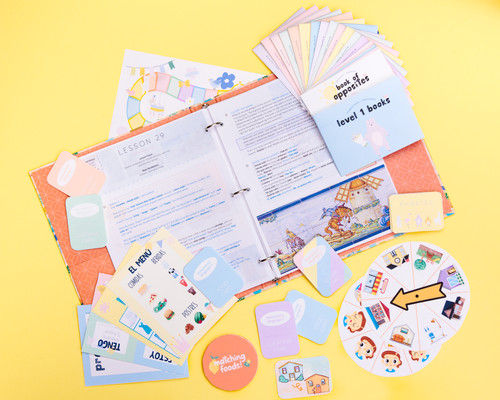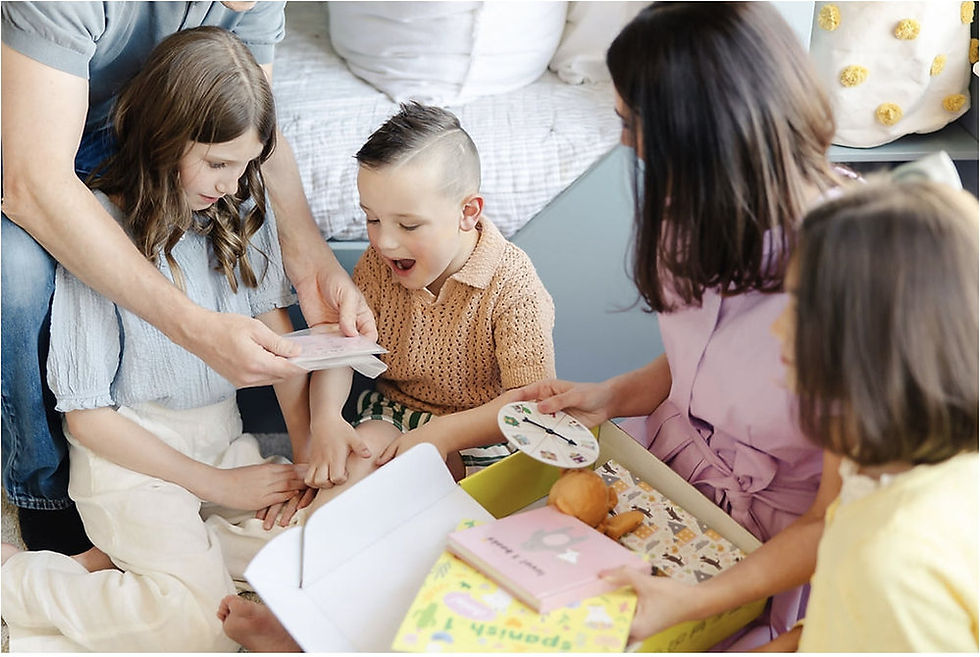Why Your Bilingual Child Won’t Speak the Language (Even If They Understand It)
- Homeschool Languages

- Jul 29
- 11 min read
Worried your bilingual child doesn't want to speak the second language?
This is more frequent than you think.
Children often go through phases where they understand a language but refuse to speak it. The good news? This is a normal part of bilingual development, and there are gentle, effective ways to help.
Whether you're raising your kids to connect with their heritage, hoping to relocate abroad someday, or simply trying to make language part of your homeschool rhythm, reluctance to speak can feel like a punch to the gut. It's frustrating. It's confusing. And if you're anything like me, it can feel a little personal.
But take a breath: this doesn't mean you've failed. It doesn't mean they're behind. And it definitely doesn't mean it's too late.
In this article, we'll cover:
Why kids avoid speaking one language even if they understand it
How this challenge shows up differently for families with cultural roots, travel dreams, or mixed-language households
What speech experts say is normal vs. what's cause for concern
How to gently, confidently encourage your child to start using the language at home
The biggest mistakes parents make, and what to do instead
🧠 If you're feeling stuck, discouraged, or like you've tried everything, you're not alone, and you don't have to do it alone either.
We give parents the tools to bring language into the home in a way that actually sticks. Not flashcards. Not drills.
Conversations that start small, build confidence, and help your kids see the language as theirs.
Want the full breakdown?
Keep reading. Let's get you unstuck.
Why This Problem Looks Different for Every Parent
When your bilingual child refuses to speak the language you're trying to teach them, it stings, but not always for the same reason.
Every family comes into this journey with a different "why," and when that dream starts to unravel, it can hit deep.
Let's talk about what this challenge feels like from five frequent perspectives. Because how you experience the reluctance matters as much as how your child expresses it.
Culturally Connected Parents
If the language you're teaching ties into your heritage, your child's refusal might feel frustrating, it might feel like they're pushing away a part of you.
Maybe it's the language your grandmother spoke, or the only way your child can talk with extended family.
When they shrug it off or respond in English, it's not about grammar. It can feel like a rejection of identity, of belonging, of legacy.
And then comes the worry. The concern that you waited too long. That you didn't make it fun enough. That they're losing a part of their story because of something you did, or didn't, do.
But let me say this clearly: it's not too late. Even if your child isn't speaking yet, they're still listening. And that matters.
Mixed-Language Families (When Only One Parent Speaks It)
In families where only one parent speaks the minority language, the burden to "make it happen" often falls completely on that parent, usually Mom.
You're told, "Speak it to them!" Like it's that easy. But what people forget is: life is loud. Busy. Messy.
And when your partner doesn't reinforce the language, or worse, your child sees that you can understand English perfectly, it becomes a losing endeavor. Why would they bother?
Even if you can speak the language, real-life fluency with kids requires more than knowledge, it takes confidence, consistency, and time (hello, three things we're all short on).
And when your child becomes reluctant, it's easy to feel like you're doing it wrong. But often, they're mirroring the home's dynamics, and that can shift with the right tools.
Homeschooling Families Wanting to Maximize Education
For homeschoolers, language isn't a subject, it's a lifestyle goal. But here's the issue: most programs treat it like schoolwork, not something kids actually use.
I can't tell you how many curriculums we tried that were beautifully designed but completely disconnected from real-life conversation.
My son could chant colors and numbers... but couldn't ask for water in Spanish. That disconnect made him lose interest fast.
And when you're already wearing 27 hats as a homeschool parent, adding language to the mix can feel impossible, especially when nothing seems to stick. You're not tired. You're burnt out.
What you really want is not one more resource, it's something that actually gets your kids to talk. That's the difference.
Parents with a Dream of Travel or Relocation
You've got the dream: living abroad, raising a bilingual child who blends in effortlessly, ordering croissants in perfect French or chatting with abuelita at the market.
But when your child won't speak the language? That dream feels like it's slipping through your fingers.
The hard part is, kids live in the now. If travel or relocation is a future plan, they may not see the point yet. To them, it's more effort in a world where English already works.
And when motivation starts to fade, so does progress. The key here is bridging the future goal with present-day relevance, and making the language feel useful today.
Parents Seeking Deeper Connection or Confidence
For some of us, language is not about academics or travel, it's about something more personal. It's about connection.
About giving your child the gift you never got. About being the kind of parent you always hoped you'd be.
So when your child mocks your accent, rolls their eyes at a phrase, or flat-out refuses to speak... it hurts. A lot.
It's easy to spiral into shame: "They don't believe me." "They think I'm making it up." "I should've started earlier."
But here's the truth: your child doesn't need a perfect speaker.
They need a present one. Someone willing to fumble through the words, show up anyway, and create a space where mistakes are part of the process.
That's not failure. That's fluency in action.
Let's be clear: no matter which group you fall into (or if you're a mix of them all), the struggle is real, but it's not final.

Is This Normal? What Speech Professionals & Bilingual Research Say
If your bilingual child isn't talking yet, or if they understand everything but won't say a word, you've probably wondered:
Is this normal?
Should I be worried?
Did I miss my window?
Take a breath. Let's look at what the research actually says.
Is it normal for bilingual kids to have a speech delay?
Bilingual kids may appear delayed early on because they're managing two systems at once.
Their total language ability (when you combine both languages) is usually right on track. It's not a cognitive delay, it's a balancing act.
Think of it like learning to ride two bikes at the same time.
They're not slower, they're splitting their focus.
At what age should a bilingual child start talking?
Most bilingual children start talking around the same time as monolinguals, anywhere between 12–18 months with first words.
But here's the catch: one language may come in faster than the other.
That's okay.
The dominant language usually takes the lead, and the second language often follows with continued exposure and interaction.
Don't panic if your child seems "behind" in one language. Look at overall comprehension and communication across both.
What is it called when a child chooses not to speak?
There are two terms to know:
Passive bilingualism:
The child understands the second language but chooses not to speak it.
This is very frequent, especially when the second language is only used in one environment (like at home).
Selective mutism:
A rare anxiety-based disorder where a child can speak but consistently chooses not to in certain settings.
This is different and usually shows up in multiple contexts, not with a second language.
In most cases, your child isn't experiencing selective mutism, they're navigating bilingual development.
Are bilingual kids' speech delayed?
Not truly. They may say fewer words in each language individually, but their total vocabulary is usually right on pace with their monolingual peers.
What matters more than how early they talk is how often they interact. Language grows through use, not exposure alone.
If they're understanding directions, responding nonverbally, or showing comprehension, you're on the right track.
It's completely normal to worry. I did too. But once I realized my kids were still thinking in Spanish, even if they weren't responding right away, I stopped panicking. And that shift? It made all the difference in how I taught them next.
Up next: what to do when they can speak... but still won't. Let's get practical.

Practical Tips to Encourage a Bilingual Child to Speak
Reader question: "What do I do when my child doesn't want to talk?"
Oh friend, I've been there. There's nothing more discouraging than pouring your energy into speaking a second language at home... only to get a blank stare or a muttered "no" in English.
But don't worry, this isn't the end of your bilingual journey.
In fact, it might be the start of the good stuff. When your child becomes reluctant to speak, it's not a rejection of you. It's a cue to change your approach.
Here's what worked for us (and what's now built into every layer of Homeschool Languages):
1. 🛑 Stop Translating Everything
If you’re saying, “Agua. That means water. Can you say water? Say agua…”, pause.I know it feels helpful, but constant translation trains your child to wait for the English instead of engaging with the second language.
Instead, use Spanish (or your target language) in context: “¿Quieres agua?” Then point, gesture, or show the cup. Let the language stand on its own as the way things are said in your home.
At first, they may not respond. That’s okay.
But the message is clear: This is the language we use.
2. 🗣 Use Scripts, Not Pressure
Ever said, “Just say it!” or “How do you say this in Spanish?” and gotten a total shutdown?
That’s because open-ended prompts feel like pop quizzes. And kids, just like us, don’t like being put on the spot.
Instead, use modeled replies. You go first, and then prompt gently. For example:
🧒 “Quiero… uh… rojo…”👩 “Ah, ‘Quiero el vaso rojo.’ You want the red cup? Great job!”
This builds confidence. And confidence leads to speaking.
(Our curriculum is packed with these kinds of scripted phrases, so you never have to wing it.)

3. 🧸 Let It Be a Game
One of my biggest breakthroughs? A puppet.
My son wouldn’t speak Spanish to me. But he would talk to a stuffed fox named Diego, who “didn’t speak English.”
Suddenly, Spanish wasn’t weird, it was fun. It was a game. And the pressure? Gone.
Try role play, characters, or even “the floor is lava unless you say it in French.” Whatever gets them giggling, go with it.
4. 🧍♂️ Make It About Them
Forget vocab lists. If your child wants to talk about dinosaurs, let the next five phrases be about T. Rex.
If they want to be a chef, make every sentence about cooking.
Let their interests lead. Why? Because language tied to desire is the language that sticks. You’re not teaching nouns, you’re unlocking motivation.
Even one phrase like “I want juice” or “I am the blue dragon” gives your child a sense of ownership.
5. 🔁 Reinforce Without Correcting
This one’s big. Constant correction can make your child feel like they’re failing, even if they’re trying.
So instead of saying “No, that’s wrong,” try this:
👧 “Yo gusta leche.”👩 “Ohhh, a mí me gusta la leche too! Let’s get some!”
You’re reinforcing the correct structure while still celebrating the effort.
Language learning is messy. But with gentle repetition, they’ll start to adjust, and even self-correct.
These tips aren’t theory.
They’re the very things that turned my own home from an awkward “language experiment” into a place where Spanish just happens. Not because I’m fluent. But because I stopped trying to force it, and started building connection.
Keep going. You’re doing better than you think.

Why Most Parents Struggle Alone, and Why You Don't Have To
Let's be honest. Most of us didn't grow up bilingual. We didn't see it modeled. We didn't have a plan. We knew we wanted to do better for our kids.
But somewhere between downloading one more app and bribing our child to say una palabra, we hit a wall.
The DIY Route:
You're drowning in apps, books, and tutor lists, but nothing seems to stick.
Your child can say a few words... but won't use them in real life.
You feel like you have to be fluent before you're even allowed to start.
And worst of all? Progress feels invisible. One week they're into it, the next? Total shutdown.
I get it. I was fluent in Spanish and still couldn't get my kids to speak. Not because I lacked knowledge, because I lacked a system.
And that's why I created Homeschool Languages.
✅ With Homeschool Languages, you get:
A full script, so you always know what to say, and when.
No-prep, 5-minute lessons you can start today, even if you're not fluent.
Built-in speaking routines that lead to actual conversation, not vocabulary alone.
Interest-led themes, so your child wants to engage (dinosaurs, snacks, superheroes, yes, please!).
Subtle structure that creates consistency without power struggles.
We don't teach your child alone. We equip you.
Because your child doesn't need a drill sergeant. They need a guide. And so do you.
Ready to Try Something That Actually Works?
You don't need another stack of flashcards. You don't need to feel bad for not being consistent. And you definitely don't need to become fluent overnight.
What you need is a clear, joyful way to bring the language into your daily life, without stress, shame, or sticker charts.
Try your first lessons free. Let your bilingual journey begin, this time, with confidence.
No more second-guessing.
No more silent standoffs. Connection, conversation, and one tiny phrase at a time.
You've got this. And we've got your back.

Questions from Parents (That You Probably Have Too)
Let's be honest, most of us have googled these questions at 11:47 PM with a heavy heart and a lukewarm cup of tea.
If that's you, you're in good company. These are raw questions I've asked (or cried through) myself.
"How do I get my child to reply instead of understanding?"
Give them low-pressure reasons to want to reply.Start by modeling responses and using phrases that invite participation instead of demanding it.
For example, instead of asking "How do you say this in Spanish?", try "I'm going to say it like this, want to try too?"
Make it about joining, not performing.
Over time, passive understanding can flip into active speaking... especially when the interaction feels playful and safe, not like a quiz.
"Why will my child speak Spanish to my mom, but not me?"
Great question, and one I hear all the time.
Your child may associate Spanish with Grandma because she's the only person who uses it. That relationship is clear and consistent.
With you, if they know you speak English too, they'll default to what's easiest. It's not rejection, it's efficiency.
To change that pattern, try creating "Spanish-only zones" or routines where you consistently stick to the target language, bedtime, snacktime, walks, etc. That repetition builds the same connection they already have with Grandma.
"Can I restart if we quit for 6 months?"
Absolutely. And I'm proof of that.
We paused Spanish in our home for a whole season because life got life-y. When we came back to it, I was surprised at how much my kids had retained, and how quickly things picked back up once we had structure again.
Language doesn't disappear. It settles in. You're never starting from scratch, you're restarting from somewhere.
(If you need help, Homeschool Languages is built for exactly this, short, scripted lessons that ease you back in.)
"Should I correct mistakes or let them talk?"
Let them talk.
Yes, you'll want to reinforce the right version eventually, but constant correction makes speaking feel risky. Instead, model the correct phrase in your response:
"Yo gusta pizza."
"¡A mí también me gusta la pizza!"
They'll start adjusting naturally as they hear patterns repeated in meaningful ways.
"What if they make fun of my accent?"
This one cuts deep, doesn't it?
It's easy to feel disheartened when your child laughs or questions your pronunciation. But remember: kids are not trying to be cruel, they're noticing a difference, and testing your reaction.
Stand your ground with a smile:
"Yep, I sound a little different, but I'm proud of learning this, and you can be too."
You're modeling bravery. And that's the best accent of all.
"Is it too late once they start school?"
Not at all.
In fact, school-age kids can pick up language faster than toddlers when they're motivated and supported. They already have a grasp of grammar, reading, and pattern recognition, all of which help them thrive in bilingual learning.
The key is to make the language real. Give it a purpose, tie it to their interests, and let it feel like a tool, not a task.
The truth?
Every one of these questions has answers. And more importantly, they have hope.
You don't need to do this perfectly. You need to do it together, with connection, with joy, and with the right kind of support.




Comments